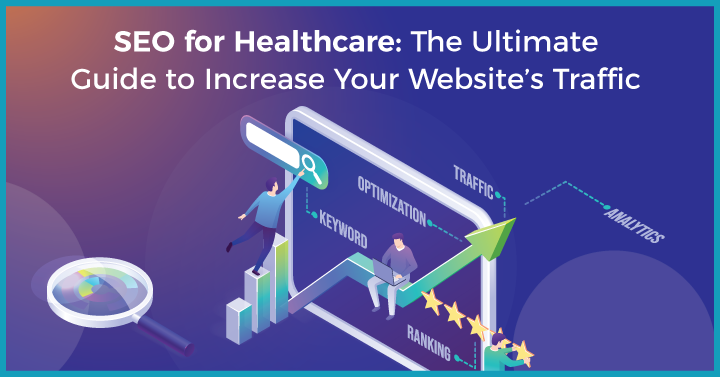In a world where a staggering 93% of online experiences begin with a search engine and 75% of users never scroll past the first page of search results, the importance of SEO cannot be overstated. This also highlights that the need for effective SEO strategy in the B2B SaaS industry is more pressing than ever.
Hence, B2B SaaS businesses should prioritise SEO to enhance the visibility of their product offerings, leading to higher conversion rate and better ROI over time. Furthermore, B2B interactions involve longer sales cycles, multiple stakeholders, and a more intricate buying journey.
In this context, SEO becomes the guiding anchor that steers potential clients through their journey, helping them discover, evaluate, and ultimately choose the B2B SaaS solution that perfectly aligns with their needs.
This comprehensive blog offers you insights on how you can construct a robust SEO strategy tailored to the unique needs of your B2B SaaS business.
2. What Is B2B SaaS SEO?
Before delving into B2B SaaS SEO, it is important to understand the unique characteristics of this industry. These companies target niche markets, have longer sales cycles, and rely on inbound leads. Given the distinct keyword landscape from B2C, meticulous keyword research is crucial for SaaS businesses. Therefore, it is crucial to understand the audience’s search intent for crafting content aligned with their needs. Now, let’s define SEO for B2B SaaS companies.
SEO for B2B SaaS involves a range of strategies and techniques to improve a website’s visibility on search engines. This includes optimising the website’s content, meta tags, URLs, and technical aspects, as well as building high-quality backlinks. The goal is to ensure that the website ranks higher in organic search results for relevant keywords and phrases. This makes it easier for potential customers to find the company when searching for related products or services.
By implementing effective SEO strategies, B2B SaaS companies can attract highly relevant and qualified traffic to their websites, increasing the chances of converting visitors into leads and customers. In addition, SEO helps establish the company’s credibility and authority in the industry, making it a trusted source of information and solutions.
3. How Important Is SEO in a SaaS Business?
SEO for B2B SaaS can drive consistent traffic and growth, because of which many businesses are increasing their investment in it. The top performing B2B SaaS companies create different types of content at different stages of the sales funnels – as a part of their SEO strategy.
- According to Databox, 67% of B2B companies create top-of-the-funnel content, and 28% create content for people in the middle of the funnel.
- As opposed to B2C, 80% of decision-makers in the B2B industry prefer to go through informational articles rather than advertisements.
These two statistics testify that content plays a vital role in driving traffic to the website. If your website has thought-provoking content that is being published on a regular basis, you can drive the target audience to the top of the funnel. Before we delve deep into the significance of SEO in the SaaS business, let us know
- What is B2B SaaS content?
B2B SaaS content is an important element of B2B SEO strategy that helps in improving the search ranking and attracting potential visitors. It not only brings the readers to your website but also allows you to take a sales approach to position your brand. This type of content is usually more formal and targeted to convince the reader to take action.
- How is B2B content different from B2C content?
While B2B content focuses on building the brand, B2C content has a transactional focus. It is targeted toward short sales cycles and used to promote products or services among consumers through engaging content.
- How do you create a SaaS content marketing strategy?
To create a long-lasting and impactful SaaS content marketing strategy, you should first define your target audience, identify their pain points and relevant keywords, define the goals, create content production methods, and monitor the results.
Most B2B SaaS content marketing strategies focus on the top of the funnel and generate conversions like – signups, ebook downloads, or demo requests. Following this approach, SaaS companies publish large guides, pilar articles, and how-to guides to achieve fast results. However, it may not give the desired results due to the changing needs of customers.
You need a strategic approach to drive the target audience to your website and convert them into potential customers.
- How do you write B2B SaaS content?
When it comes to creating B2B SaaS content, there are two things to talk about – 1) the problem of your audience and 2) the solution you have. Your website should highlight these two important things to attract the right audience. In short, you need to understand the intent of the search and ensure the reader’s queries are resolved when he/she visits your webpage.
For instance, Lumen5 is a SaaS-based video creation platform that helps users create stunning videos. Video is one of the powerful modes of marketing, and not everyone has the skills to create videos. Lumen5 solves this problem by helping users easily convert text into videos.
If you look at their website, you’ll find that their content is inclined towards the audience’s problem (not having skills to create videos) and solution (how Lumen5 help create videos). Currently, the website drives monthly visitors of 220K+.
Now, is it just content that is driving traffic to the website?
No. The key behind the traffic is a well-planned SEO strategy for SaaS.
But how do you think SEO contributes to growth in an enterprise SaaS?
Well, enterprise SaaS SEO helps in increasing organic traffic by increasing the visibility of your company’s website to those
- Searching for the software or product that your SaaS company offers
- Searchers who would like to compare the price of your products and compare it with others
- Who would like to know more about your products
Let us understand the importance of SEO for SaaS and why you need to invest in it
- Enhance Brand Reach
Building brand awareness is all about boosting reputation. Getting some serious traction at reputed sites like Reddit, Forbes, Entrepreneur, and PcMag can take your brand recognition through the roof. With effective link building, you can gain a bigger audience and build your brand value. Let us understand this with the below example.
Donorbox, a US-based SaaS firm offering nonprofit fundraising software, wrote a guest post for Socialbrite. By including some of its notable campaigns in the guest post, the company enhanced its brand reach seamlessly.
- Drive More Traffic to Your Website
You can expect monthly traffic growth when you implement the right SEO strategy. It can look like creating valuable content for the target audience, promoting content to earn backlinks, and utilising the data collected from landing pages to drive growth and achieve top rankings.
- Gives an Edge Over Competitors
SaaS companies looking to gain competitive advantage have several channels to leverage. However, SEO provides more targeted lead generation than any channel. Acquiring high rankings in organic listings is an accomplishment as it gives your business the authority and credibility it needs to establish trust with your customers.
- Reduce Expenditure on Paid Advertisements
When you invest in paid media advertising, your website gets traffic with every click on the ad. And you’ll have to pay for every single click. However, the cost of acquiring customers increases over time, as your CPC is directly proportional to the keyword competition. With SEO for Saas, you can acquire new customers at much lesser rates than paid marketing. It is ongoing investments that won’t increase over time and help you yield a higher return on investment.
- Influence Buyer’s Decision
One of the first impressions of your brand is company reviews. Online reviews typically hold a lot of weight when it comes to Google rankings. Consumers and B2B decision-makers often turn to Google, Bing, or Yahoo to learn more about your business. You are more likely to gain sustainable business by controlling your brand’s narratives. Using SEO to shape your consumer’s perceptions will deliver more benefits to your business.
4. The 9-Step SEO Strategy to Scale Up your SaaS Business
4.1 Set the Goals
The first step in SEO for B2B Saas is to set goals and list out the KPIs to measure. Without knowing what to achieve, you will not be able to understand whether you are on the right track. It will help you see what you need to do to achieve more growth. Here are some common examples of SEO goals for SaaS companies
- Increase monthly conversion rate by 12%
- Acquire 5000 new customers in the next six months
- Generate an annual recurring revenue of $1 billion in 12 months
To achieve these goals, you need to measure the KPIs that provide a snapshot of how the SEO campaign progresses over time. Besides the SEO goals, you also need to analyse metrics like Customer Acquisition Cost (CAC), Monthly Recurring Revenue (MRR), Customer retention, and more to ensure the SEO goals are aligned with your organisation’s strategic objectives.
4.2 Know your target
The next step is to know your target. Understanding the target audience’s requirements is imperative to know the type of content to create to attract them. Your conversion chances are very low if your target audience includes everyone.
To start with, you need to build profiles of the different categories of people you are targeting. You can talk to your teams and gather information about the audience, their interests, behaviour, and persona. The objective here is to know your audience better to create personalised marketing campaigns. Here are a few considerations to identify your target market
- Where to find your target audience?
Find out the sites your target audience is likely to visit, the blogs they read, and the social media platforms they hang out with.
- How do they describe your services or products?
Most of the products are described in technical terms. Therefore, when describing your SaaS product or service, you should find the terms or phrases your target audience uses
- What are their decision criteria?
They may consider a few factors when choosing a similar product or service. You should have a clear picture of what they look at when making a decision? It will help you create compelling content that convinces them to favour your company. If you are unsure how to identify and segment the target audience for better decisions, you should consider hiring a reliable SaaS SEO agency.
4.3 Know Your Competitors
Competitor analysis is one of the critical elements of SEO. By keeping a tab on your competitor’s backlinks and content strategy, you will know what’s working for them and what’s not. You can use SaaS SEO tools to get insights into your competitor’s organic traffic, indexed keywords, backlinks, and more.
With competitor analysis, you can identify strategic opportunities that help you stay ahead. Start by evaluating your competitors – founding date, revenue, employee count, growth, and upcoming products. Then, you should keep track of their marketing efforts by following their blogs, press releases, case studies, and guides.
For example, if you provide accounting software, you will have to compete with companies that sell similar software. Check their official website through a simple search and collect as much information. If they have an online store, you can understand their strategies to acquire new customers.
You can also find out more about your competitors on SaaS review websites like – TrustRadius, Crunchbase, Capterra, and G2. Check out the SEMRush competitor research tool – if you are unsure of their keywords and organic visibility.
This way, you will determine the tactics used by your competitors to reach out to their customers.
4.4 Build a Keyword Strategy
Keywords play an essential role in SEO for B2B SaaS, as they help you fill the top of the funnel with those looking for SaaS-based products or services. You will be able to reach larger audiences by identifying the right keywords. You can start by listing the problems your platform/product/service can solve to find relevant keywords.
Think of the questions, challenges, or problems your customers are likely to face. Once you have prepared a list, identify the most searched keywords. Certain SaaS SEO tools like SEMRush, Ahrefs, Moz, and UberSuggest can help you identify the keywords with high search volume and difficulty levels.
Think of general terms like – software, platform, solution, accounting automation, API integration, accounting import, etc. In addition, we recommend using the name of integration partners, as most of the SaaS products integrate with other tools and platforms.
If the competitor is dominant in your space, you can use the ‘alternative’ keyword. For example, let’s say you are building a CRM tool; use the keyword – a competitor of Salesforce or Salesforce alternative.
Build a content strategy around those keywords to push your prospects further into the sales funnel.
4.5 Optimise the Landing Pages
A landing page is a single webpage that helps you generate leads and drive conversions. Make sure you are using relevant keywords for your product and feature pages. For example, some popular keywords in the SaaS category are Free CRM, Open Source CRM, Small Business CRM, Customer Service tool, etc.
Before you build a landing page, define your goals clearly. Below are the examples of landing page goals
- Filling out a form
- Signing up for a newsletter
- Downloading ebook
- Registering for subscription
Here is an example of the best SaaS landing page for signups.
Taskade
Taskade is a real-time collaboration tool that helps remote teams work in a unified space. The key highlights of its landing page are –
- A clear headline and description that delivers the product value clearly
- Two signup buttons – one under the product description and another on top-right on the menu
- Product demo in a stunning and attractive colour scheme
- Icon CTAs below the image
Once you have the list of relevant keywords and goals to accomplish, start building the landing pages. Make sure to highlight the USP of your products/services that convince the visitor to take action.
4.6 Improve On-Page SEO
For B2B SaaS to succeed, you need to optimise the website by creating better content than your competitors. Whether it is the product page, blog content, or landing pages – every page requires better content and keywords than your competitors
Now, what does better content mean?
In B2B SaaS, better content means the one that answers the search query better than other results. It can be long, relevant, in-depth, engaging, and informative.
Make sure the content on your website fulfills the search intent or user intent. It is essential to team up with an experienced SaaS SEO agency to find ways to improve your website’s content.
Check the on-page SEO checker to get a wealth of ideas to improve the on-page SEO of your SaaS website.
4.7 Build High-Quality Backlinks
Link building, also known as off-page SEO, will help your content rank for relevant keywords. Some of the best tactics for SaaS companies include – broken link building, guest posting, resource link building, digital PR, and forum posting.
Start finding backlink opportunities by running your domain through link-building tools and choosing your competitors. You need a solid link-building strategy that helps you earn relevant links to your content.
If your website is brand new, you will have a tough time ranking the website, as link building takes time. However, once you build up the domain authority, it will improve the rankings across the site. Besides external linking, you should spend time internal linking B2B blogs.
Create a power post with lots of designs, illustrations, and infographics that not only engages the readers but can be used for generating backlinks and social media shares.
4.8 Don’t Overlook Technical SEO
This is the trickiest part of your company’s SEO strategy. If your website suffers from technical issues and faces issues getting indexed on Google, your efforts go in vain.
Many websites face technical SEO issues such as no XML sitemaps, meta robots, slow page speed, no SSL certificate, incorrect robots, multiple home page versions, poor navigation, and more.
If your site faces technical issues, it is held back from reaching its full potential. You can use site audit tools to find opportunities to improve your website’s technical SEO. Here are the critical areas of your website to check for technical SEO –
- Is your SaaS website crawlable by search engines?
A technically healthy website is easily crawled by search engines like Google, Yahoo, and Bing. However, if you are unsure of your site’s health, various SaaS SEO tools improve the crawlability of your website and reduce errors.
- Is it too slow?
Page speed is a key ranking factor that helps search engines determine the quality of your website. If your website speed is low, Google may place other websites on top of search results. You can speed up your website by taking a few measures like – compressing the images, minifying the CSS and JavaScript, and implementing CDN and cache.
- Is the website secure?
Websites that follow the best security measures, such as SSL encryption, are likely to gain the trust of search engines. Conversely, any lapse in security can decrease the visibility of your website.
- Do search engines index it?
Indexing is an essential element in technical SEO that ensures search engines quickly access your website. To ensure Google renders the content, you need to use canonical tags, redirects, javascript, and caching appropriately. Take a proactive approach to building a technically strong foundation.
4.9 Measure the KPIs/Results
Key Performance indicators (KPIs) for SEO are the foundation for a strong business that helps you understand your business growth. Through Google Analytics and other platforms, you can generate reports on important actions such as demo requests, registration form completions, paid signups, and subscriptions. Here are some valuable KPIs for SaaS SEO –
- Bounce rate
When people land on your website and don’t find what they are looking for, they are likely to exit without spending time on it. It could be because the content is not high-quality or the search intent is not fulfilled. Use Google analytics to identify the pages with high bounce rates and optimise them with relevant content.
- Organic CTR
Click Through Rate (CTR) is another critical metric that helps you determine the effectiveness of your meta description and the strength of your brand. A higher ranking on SERPs doesn’t make sense without clicks that bring conversions. If your CTR and bounce rate are high, your content isn’t doing well. Make sure the content is easy to scan with bullet points, headings, images, and videos.
- Conversions
The main drivers of SaaS SEO are sales (conversions). Therefore, you need to ensure that your SEO strategy for SaaS supports long-term financial growth. Conversions can directly influence the key metrics like – monthly recurring revenue, qualified leads, sales cycle, customer retention rate, churn rate, etc.
Measuring the above metrics is essential, as the sum of these provides a clear picture of the search engine performance.
For example, if you like to increase organic free trials, you can measure it in terms of PQL ( if you are doing something within the product) and MQL (if you are a sales-led business). By measuring these key metrics, you will understand how your website’s traffic contributes to your business’s overall revenue and growth.
5. SEO for B2B SaaS Case Study Examples
- Salesforce
Salesforce instantly attracts visitors with an engaging layout in a blue and white colour scheme. It does a great job blending actual client pictures with animated elements and custom iconography. The strategically positioned CTAs and white space across it make the website a win. With more than 900,000 keywords and a traffic estimate of 4.3M visits per month, this SaaS company is a juggernaut in the SEO space.
- Zendesk
The website of Zendesk embodies the corporate website look with multi-coloured heading and a dark background. The first half of the website emphasises resources and multiple case studies – while the second half gains your trust with social proof of the Gartner award and reputed client logos. The website ranks for 300,000 keywords and receives estimated traffic of 3.8M.
- HubSpot
HubSpot is a leading B2B company that offers software products for inbound sales, marketing, and customer support. It ranks in position #1 of SERPs for keywords like – “market research”, “inbound marketing tool”, “branding,” and more. With 290M backlinks and 4.3M keywords, It receives more than 20.3 million organic hits every month.
- Twilio Segment
Twilio Segment has one of the best SaaS websites on the internet, with a seamless blend of brand colours across the website and a dark aesthetic feel. The custom graphic elements that explain how their software works aim to attract visitors. The website has a clean look with minimal product screenshots, social proofs, client logos, and case studies. Currently, the website ranks for 80,900 keywords and receives monthly traffic of 61,900.
6. How can a Digital Marketing Agency Help?
If you find implementing and managing SEO for your B2B SaaS company overwhelming, consider partnering with a digital marketing agency. By outsourcing your SEO efforts to a digital marketing agency, you can focus on other aspects of your business while knowing that your online visibility and growth are in capable hands.
Growth Ganik is a full-stack digital marketing agency with over 15 years of experience in executing a comprehensive SEO strategy tailored to the client’s specific business goals. We have the knowledge and resources to conduct thorough keyword research, optimise your website, build high-quality backlinks, and measure your SEO success.
So if you’re ready to boost your B2B SaaS company’s growth through SEO, schedule a free 45-minute consultation.
7. FAQS
- Why Do B2B Companies Need SEO?
B2B companies need SEO to drive organic traffic, generate qualified leads, and boost conversions. A successful SEO strategy places your B2B website in front of prospects and potential customers.
- What is the role of SEO in driving growth for B2B SaaS companies?
SEO plays a crucial role in driving growth for B2B SaaS companies by improving website visibility, generating quality leads, and increasing customer acquisition.
- How do SEO strategies differ for B2B SaaS and B2C SaaS businesses?
The SEO strategies for B2B and B2C businesses differ due to variations in their target audience, sales cycle, and content requirements. Understanding these differences helps businesses develop effective SEO campaigns that cater to B2B audience.

















